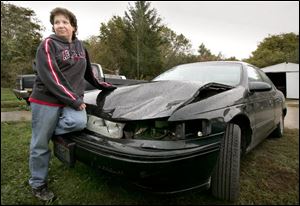
Fall means deer on move
10/21/2005
Peggy Sigler says police told her she was lucky the deer that crumpled her car didn't come through the windshield.
A split-second's distraction was all it took for Peggy Sigler to get up close and personal with a deer at 5:15 p.m. Wednesday on State Rt. 199 near Holcomb Road in southern Wood County.
"It happened really fast. All I did was look away. And when I looked back, it was there," Ms. Sigler said yesterday of the deer that shredded her Mercury Sable's front end, dented the hood, and then sailed over her roof.
"It was really big. The cop said I was lucky it didn't come through my windshield," she said.
Add Ms. Sigler's car to the statistics for the busiest time of year for deer-vehicle crashes. October is the start of mating season for deer, and bucks, in particular, tend to travel at all hours of the day in pursuit of, well, happiness.
"We've had a lot in the past few weeks," Kathy Slaughterbeck, a Wood County sheriff's deputy, said, noting that all three of her department's accident calls Wednesday involved deer.
State officials estimate that vehicle-deer collisions cause an estimated $84 million a year in damage in Ohio, $130 million in Michigan, and hundreds of injuries and handfuls of deaths in each state annually.
Last year, 29,874 deer collisions were reported across Ohio, while in Michigan the count was 62,707. There were five fatal crashes in Ohio and three in Michigan, while the injury counts were 980 and 1,466 in the respective states.
In Ohio, the highest crash counts tend to be in the eastern and southern parts of the state, but Williams County has Ohio's fifth highest percentage of deer crashes: in 2004, 32.3 percent of its traffic accidents involved deer. It also had the highest crash count in the northwest part of the state, with 472 deer collisions.
And while deer hunting may be the most lucrative farther north in Michigan, southern counties tend to have that state's highest crash counts because there's more human population and thus more traffic.
Authorities in Hillsdale County reported 1,023 deer-vehicle crashes last year, with 752 in Lenawee County. The highest crash counts - more than 2,000 each - were in Calhoun and Kent counties, where Battle Creek and Grand Rapids, respectively, are located.
Last year's Ohio crash count was 5.8 percent lower than that of 2003, and state wildlife officials estimate that the Ohio deer herd is down to about 650,000 from 700,000 a year ago following a record hunting cull.
Scott Butterworth, a wildlife management supervisor at the Ohio Division of Wildlife's district office in Findlay, said the first two weeks of November are usually the peak period for deer breeding activity in northwest Ohio. Right now, he said, "The bucks are ready [to rut], but the does aren't."
Officials in Ohio and Michigan urged motorists to reduce their risk of colliding with deer by being especially careful in marked deer-crossing areas, using high-beam headlights when there is no opposing traffic, and being aware that deer travel in groups. If one crosses the road, chances are others will follow.
In Michigan, authorities stress that motorists should not swerve violently to avoid striking a deer because they could lose control and strike other objects - such as poles, trees, or rocks - that will cause even more damage.
Ms. Sigler said she learned an awareness lesson from her experience: "Don't take your eyes off the road," she said.
Blade outdoors editor Steve Pollick contributed to this report.
Contact David Patch at:
dpatch@theblade.com
or 419-724-6094.